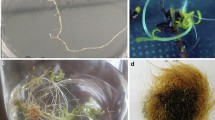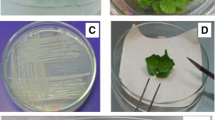Abstract
Chlorophytum borivilianum belonging to the family Liliaceae, is distributed in the pantropical regions of India and South Africa. The sapogenins (stigmasterol and hecogenin) of C. borivilianum are well known for their appetizing and aphrodisiac properties. The present study involves enhancing the sapogenin content in C. borivilianum by genetic transformations with Agrobacterium rhizogenes strains (MTCC 2364 and 532, PRT Gus). A maximum transformation frequency of 98% was obtained with Agrobacterium rhizogenes MTCC 2364 strain with rhizome explants after a co-cultivation period of 48 h. Two potential rhizoclones (2364a and 2364b) were selected for the production of stigmasterol and hecogenin. The maximum production of stigmasterol (83.952 ± 0.01 mg/g) was seen in 2364b rhizoclone, whereas, the highest accumulation of hecogenin (81.52 ± 0.02 mg/g) was observed in 2364a rhizoclone. The C. borivilianum hairy root cultures obtained in this study provide a continuous and sustainable production of stigmasterol and hecogenin on a commercial scale.









Similar content being viewed by others
References
Amali P, Kingsley SJ, Ignacimuthu S (2014) Enhanced plant regeneration involving somatic embryogenesis from shoot tip explants of Sorghum bicolor (L. Moench). Asian J Plant Sci Res 43:26–34
Baron C, Domke N, Beinhofer M, Hapfelmeier S (2001) Elevated temperature differentially affects virulence, VirB protein accumulation, and T-pilus formation in different Agrobacterium tumefaciens and Agrobacterium vitis strains. J Bacteriol 183:6852–6861
Broothaerts W, Mitchell HJ, Weir B, Kaines S, Smith L MA, Yang W, Mayer JE, Roa RC, Jefferson RA (2005) Gene transfer to plants by diverse species of bacteria. Nature 433:629–633
Chen L, Zhang B, Xu Z (2008) Salt tolerance conferred by overexpression of Arabidopsis vacuolar Na+/H+ antiportar gene in common buckheat (Fagopyrum esculentum). Transgenic Res 17:121–132
Choi SM, Son UH, Yun SR, Kwon OW, Seon JH, Paek KY (2000) Pilot scale culture of adventitious roots of ginseng in a bioreactor system. Plant cell Tissue Organ Culture 623:187–193
De F, Malafronte A, De TN et al (2004) Metabolic profiling of cells and transformed hairy roots of salvia sclarea Salvia. Annual congress SIGA XLVIII
Eugene WN (2014) Agrobacterium: nature’s genetic engineer. Front Plant Sci 5(730):730–746
Fu CX, Zhao DX, Xue XF, Jin ZP, Ma FS (2005) Transformation of Saussurea involucrata by Agrobacterium rhizogenes: hairy root induction and syringin production. Process Biochem 40:3789–3794
Gayathri B, Archana G (2012) Production of stigmasterol and Hecogenin from in vitro cultures of Chlorophytum borivilianum. J Pharmacognosy 3:2:101–103
Geier T, Sangwan RS (1996) Histology and chimeral segregation reveal cell-specific differences in the competence for shoot regeneration and Agrobacterium-mediated transformation in Kohleria internode explants. Plant Cell Rep 15:386–390
Geng L, Niu L, Gresshoff PM, Shu C, Song F, Huang D, Zhang J (2012) Efficient production of Agrobacterium rhizogenes-trans- formed roots and composite plants in peanut (Arachis hypogaea L.). Plant Cell Tissue Organ Cult 109:491–500
Gilberto SC, Gabriela DSS, Emiliano RV, Ana PFDF, Brinell AM, Danielle SM, Augusto LS, Jose MBF, Luzia KAL, Gerly ACB, Caden S, Glauce SBV (2012) Effects of hecogenin and its possible mechanism of action on experimental models of gastric ulcer in mice. Euro J Pharmacol 683:260–269
Giri A, Giri CC, Dhingra V, Lakshmi NM (2001) Agrobacterium-mediated transformation in Alpinia galanga (Linn.) wild for enhanced acetoxychavicol acetate production. Nat Product Lett 15:229–235
Gopi C, Vatsala TM (2006) In vitro studies on effect of plant growth regulators on callus suspension culture biomass yield from Gymnema sylvestre RBr. Afr J Biotechnol 5:1215–1219
Kumar M, Meena P, Verma S, Kumar M, Kumar A (2010) Anti-tumour, anti-mutagenic and chemomodulatory potential of Chlorophytum borivilianum. Asian Pac J Cancer Prev 11:327–334
Kuo RY, Qian K, Morris NSL, Lee KH (2009) Plant derived triterpenoids and analogues as antitumor and anti-HIV agents. Nat Product Rep 26(10):1321–1344
Lowe K, Wu E et al (2016) Morphogenic regulators Babyboom and Wuschel improve monocot transformation. Plant Cell 18:1998–2015
Oudhia P (2000–2001) Problems perceived by safed musli (Chlorophytum borivilianum) growers of Chhattisgarh (India) region: a study. J Med Arom Plant Sci 22(4A) & 23(1A):396–399
Pandey R, Krishnasamy V, Kumaravadivel N, Rajamani K (2014) Establishment of hairy root culture and production of secondary metabolites in Coleus (Coleus forskohlii). J Med Plant Res 8(1):58–62
Patra N, Srivastava AK (2016) Artemisinin production by plant hairy root cultures in gas and liquid phase bioreactor. Plant Cell Rep 35(1):143–153
Ponou BK, Barboni L, Teponno RB, Mbiantcha M, Niguelefack TB, Park HJ, Lee KT, Tapondjou LA (2008) Polyhydroxyoleanane-type triterpenoids from Combretum molle and their anti- inflammatory activity. Phytochem Lett 1(4):183–187
Praveen CV, Laiq ur Rahman, Arvind SN, Dharm CJ, Khanuja SPS, Suchitra B (2007) Agrobacterium rhizogenes-mediated transformation of Picrorhiza kurroa Royle ex Benth.: establishment and selection of superior hairy root clone. Plant Biotechnol Rep 1(3):169–174
Rao K, Bhuvaneswari C, Lakshmi NM, Archana G (2012) Agrobacterium-mediated transformation in Alpinia galanga (Linn.) Willd. for enhanced acetoxychavicol acetate production. Appl Biochem Biotechnol 168:339–347
Savona M, Mascarello C, Bisio A et al (2003) Optimization of the extraction of a new compound, tissue culture and hairy root transformation. Agr Medit 133:28–35
Sharafi A, Sohi HH, Mousavi A, Azadi P, Razavi K, Ntui VO (2012) A reliable and efficient protocol for induction of hairy roots in Papaver bracteatum. Plant Cell Tissue Organ Cult 113(1):1–9
Soham T, Hipal G, Mayank G, Nikhil G, Prasad P, Girish G et al (2009) Establishment of Agrobacterium-mediated genetic transformation in Jatropha curcas L. Int J Agric Sci 1(2):11–20
Sparg SG, Light ME, Staden J (2004) Biological activities and distribution of plant saponins. J Ethnopharmacol 94:219–243
Subhashree D, Singhal S, Naveen K, Rao CM, Sumalatha S, Dave J, Rajeshkumar D, Krishnadas NK (2016) Standardised extract of safed musli (Chlorophytum borivilianum) increases aphrodisiac potential besides being safe in male Wistar rats. Androl Vol 48:10:1236–1243
Surendra K, Kakoli B (2014) A comparative study of hairy root culture induction efficiency in four medicinally important plants using Agrobacterium rhizogenes. Int J Curr Microbiol Appl Sci 3:5:625–633
Tiwari RK, Trivedi M, Guang ZC, Guo GQ, Zheng GC (2008) Agrobacterium rhizogenes mediated transformation of Scutellaria baicalensis and production of flavonoids in hairy roots. Biol Plant 52(1):26–35
Tusevski O, Stanoeva JP, Stefova M, Simic SG (2013) Phenolic profile of dark-grown and photoperiod- exposed Hypericeum perforatum L. hairy root cultures. Sci World J 2013:1–9
Vrishali V, Snehal SD, Neha AG (2016) Hairy root culture: a promising approach in Biotransformation. Asian J Plant Sci Res 6:6–11
Yan LL, Zhang YJ, Gao WY et al (2009) In vitro and in vivo anticancer activity of steroid saponins of Paris polyphylla var. yunanensis. Exp Oncol 31:1:27–32
Acknowledgements
This research work has been supported by JNTUH, Kukatpally. We sincerely thank them for their support.
Author information
Authors and Affiliations
Contributions
GB has done the entire work, KR helped in paper writing, AG was the guide in Research.
Corresponding author
Ethics declarations
Conflict of interest
There is no conflict of interest between the authors.
Additional information
Communicated by Dr. Silvia Moreno.
Electronic supplementary material
Below is the link to the electronic supplementary material.
Rights and permissions
About this article
Cite this article
Bathoju, G., Rao, K. & Giri, A. Production of sapogenins (stigmasterol and hecogenin) from genetically transformed hairy root cultures of Chlorophytum borivilianum (Safed musli). Plant Cell Tiss Organ Cult 131, 369–376 (2017). https://doi.org/10.1007/s11240-017-1290-8
Received:
Accepted:
Published:
Issue Date:
DOI: https://doi.org/10.1007/s11240-017-1290-8




